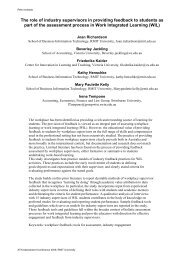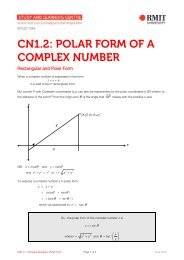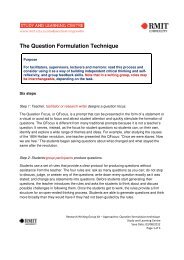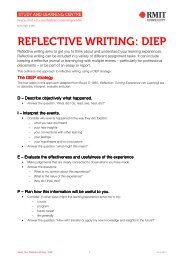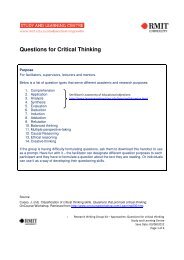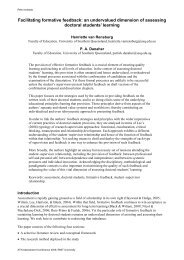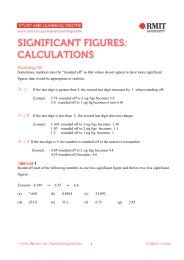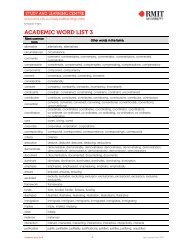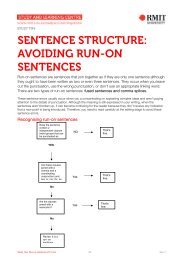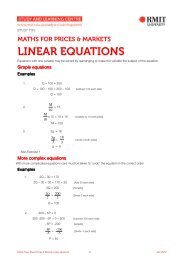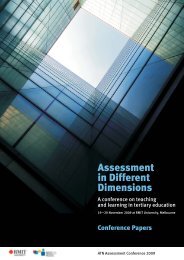student feedback and leadership - Office for Learning and Teaching
student feedback and leadership - Office for Learning and Teaching
student feedback and leadership - Office for Learning and Teaching
Create successful ePaper yourself
Turn your PDF publications into a flip-book with our unique Google optimized e-Paper software.
Part A: Developing a Distributed Leadership Model - Secton 3: Building Leadership Capacity<br />
––<br />
Several RMIT internal projects, Work Integrated <strong>Learning</strong> <strong>and</strong> Graduate<br />
Capabilities, have a adopted a participative <strong>and</strong> collaborative multi-level<br />
<strong>leadership</strong> model to in<strong>for</strong>m new policy <strong>and</strong> procedures.<br />
A further important change has been the development of supportive systems<br />
<strong>and</strong> procedures to recognise <strong>and</strong> reward academics <strong>for</strong> taking <strong>leadership</strong><br />
in learning <strong>and</strong> teaching:<br />
––<br />
In December 2008 the DVC(A) announced a new emphasis on the weight<br />
given to the contribution of teaching in promotion decisions. This is to be<br />
achieved by a broadening of emphasis that will require some combination<br />
of teaching, <strong>leadership</strong> <strong>and</strong> scholarship in all academic promotions (except<br />
in the case of research-only appointments). The new approach relies upon<br />
the following definitions of teaching, <strong>leadership</strong> <strong>and</strong> scholarship:<br />
––<br />
<strong>Teaching</strong> refers to the practice of teaching <strong>and</strong> requires evidence<br />
of excellent per<strong>for</strong>mance in <strong>student</strong> outcomes, such as progression<br />
rates, <strong>student</strong> <strong>feedback</strong> measures <strong>and</strong>, where applicable, success<br />
in higher degree supervision.<br />
––<br />
Leadership refers to motivating, influencing <strong>and</strong> inspiring others<br />
to achieve the goals of the University. The promotion application<br />
should evidence <strong>leadership</strong> aligned with the emphasis the applicant<br />
has placed on his or her teaching, research or both. For those<br />
wishing to emphasise teaching, there should be solid evidence<br />
of <strong>leadership</strong> related to teaching, such as per<strong>for</strong>mance in course<br />
or program innovation, design <strong>and</strong>/or co-ordination; or in mentoring<br />
or supervising teaching staff.<br />
––<br />
Scholarship refers to the generation of knowledge <strong>and</strong> its<br />
application to the solution of real world problems. It includes<br />
Excellence in Research <strong>for</strong> Australia (ERA) indicators <strong>and</strong>/or learning<br />
<strong>and</strong> teaching inputs <strong>and</strong> outputs. <strong>Learning</strong> <strong>and</strong> teaching inputs<br />
<strong>and</strong> outputs can be operationally defined as those that would<br />
be accepted by ALTC as teaching citations, ALTC grants, new<br />
courseware, websites, presentations, <strong>and</strong> dissemination strategies.<br />
This important change illustrates the opportunity to triangulate reward <strong>and</strong><br />
recognition of academic excellence via internal <strong>and</strong> external awards. Figure<br />
13 presents a framework to provide such an accreditated process. The 2008<br />
RMIT University <strong>Teaching</strong> Awards included an award <strong>for</strong> Student Centred<br />
<strong>Learning</strong> in the Business discipline to one of the ART members. This award<br />
was made <strong>for</strong> the innovative teaching practice he introduced as part of this<br />
project.<br />
Page 63



